In the Lost and Drowned Town of Etowah, Georgia
By: Amy Young
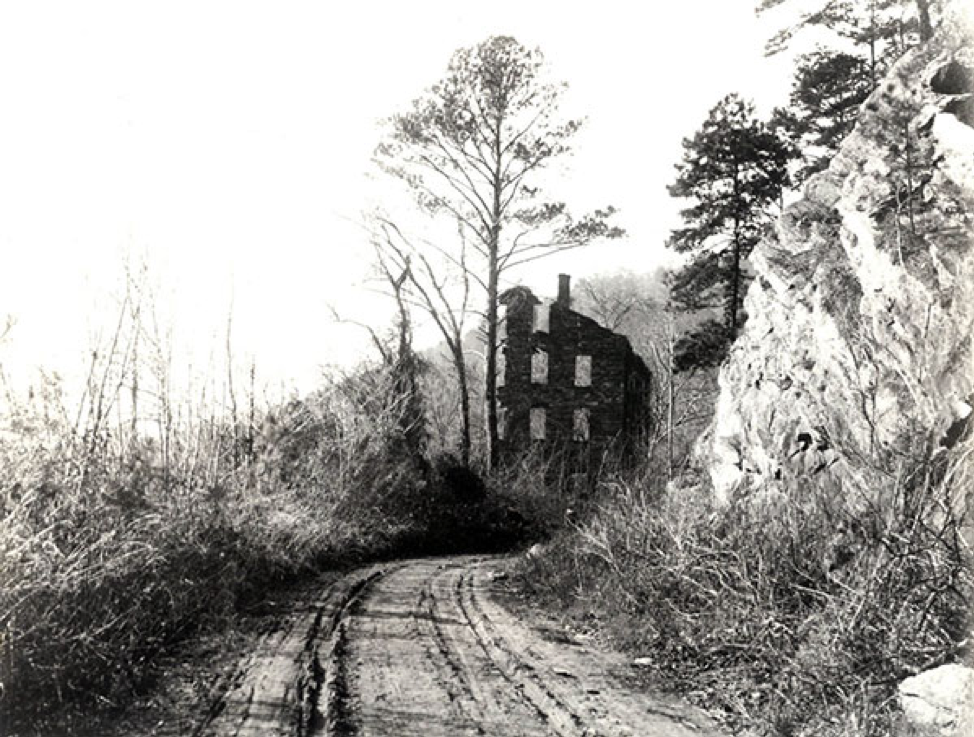
Rising from the red clay-stained waters of Lake Allatoona, Glen Holly teases a few times a year. When the water retreats, a home place appears. War, fire, nature and water have finished their work to dismantle the mansion. Gone are the vineyards, orchards, and gardens, but the Cooper family has kept the legacy alive. Out of miry shadows lost history materializes.
Mark Anthony Pope, III wrote the comprehensive book, Mark Anthony Cooper: Iron Man of Georgia. Pope’s book paints the landscape of the Cooper story. His cousin Barry Wright, III focused on the details and his great-grandfather in, John Paul Cooper: Georgia Giant in the Revival of Cotton during the Early 1900s. Wright’s work and his generous gift of sharing his family papers add living color to the sepia past.
Wright remembers his childhood visits to Glen Holly. His grandfather, Frederick, told tales of the family patriarch, “The Old Major,” and his eccentric Uncle Eugene and Aunt Rosa. He then introduced his grandson to Glen Holly.[1]
Mark Anthony Cooper built Glen Holly on a hill upriver from The Etowah Manufacturing and Mining Company. Eugene Cooper, Mark Anthony’s only surviving son described Glen Holly in an 1885 Atlanta Journal article: “Glen Holly was beautiful place, nestled on the ragged crags overlooking the sparkling, laughing waters of the Etowah.”[2]
Decades later, the US Army Corp of Engineers built a dam to impound those laughing waters, covering the remains of Etowah and Glen Holly. Sherman did his best to erase the manufacturing town. Two fires obliterated the family home. Fire, war, and water may have suppressed this Bartow treasure, but the Coopers continue to conjure the ghosts of Glen Holly.
Wright walked Glen Holly with his grandfather and took a canoe to the “island” as a teen. But it was not until he grew up and received a box of family papers and photographs that he began to understand, “I got a sense of the house, orchards, gardens, outbuildings as actual history. For the first time, my family history was real.” Wright continued, “The descriptions and conversations I’d read in the letters and accounts now made absolute sense.” Trips to Glen Holly woke his mind: “I could see The Old Major cultivating his apple orchard, including two varieties named for Cooper. I imagined Uncle Eugene planting the dozens of peach trees his nephew, John Paul Cooper, had bought him.” Wright stirred up the past and shadowy stories of Etowah and Glen Holly have found new life.[3]
In 2012, Wright paddled toward Glen Holly with his daughter in a small canoe and kayak. In the winter, the Lake Allatoona is low and he was able to see what remained of his family’s home place. He found chimney brick scattered on the red clay knoll and much of the stone wall that surrounded the property remained albeit submerged in most places.
Wright picked up pieces of the past—glass, china and something dated and special. Wright reported, ” One fragment, the spout of a glass pitcher, had the date 1838 still intact and showing.” The Cooper family kept their past intact by recording their history. Besides the mounds of correspondence, documents, and images – they had their stories. Wright’s visits to Glen Holly and hours of research prove the family stories are true. In the process of rediscovery, the ghosts of Glen Holly were summoned.[4]
When Mark Anthony Cooper left his political career to build an iron business and establish the town of Etowah, he picked a prime piece of real estate in town to build the Cooper home place, Glen Holly. He built up the river away from the noise of the Iron Works. The Etowah River was in view and watered his orchards, vineyard, and gardens. It was surrounded by outbuildings that served as smaller homes for family members. The center piece, the home was surrounded by a stone wall, that survives under the waters of Lake Allatoona.
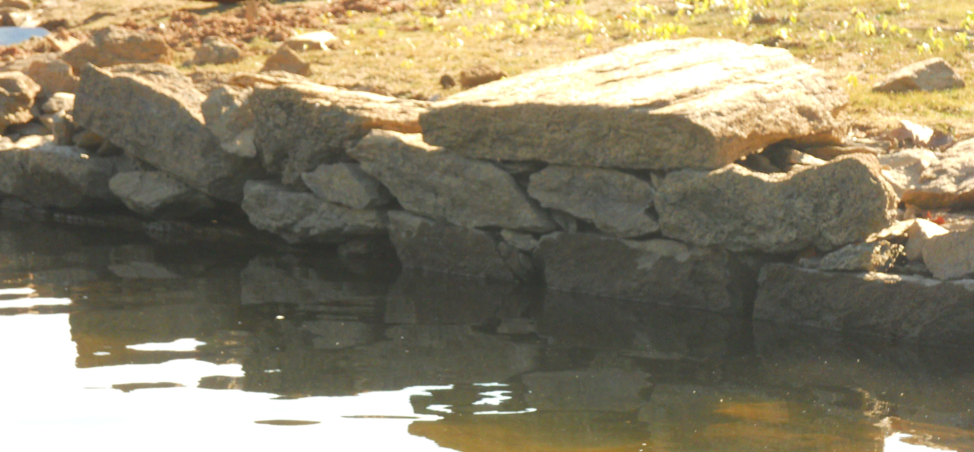
Remnants of the rock wall surrounding the Glen Holly home place during low water
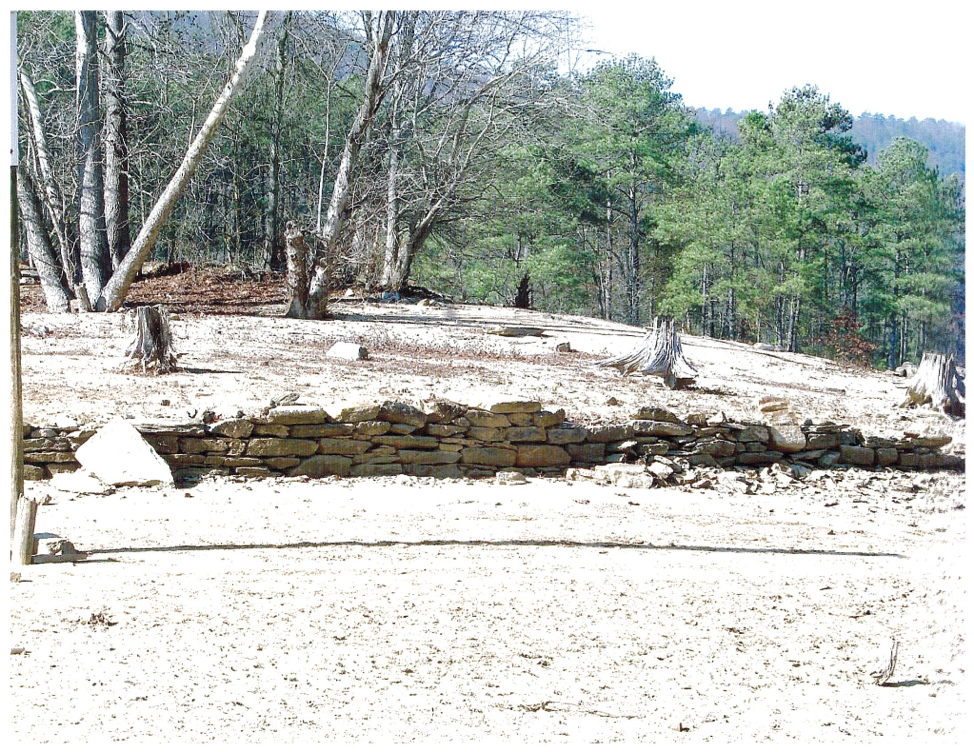
[1] Barry Wright, III, Email Interview, January 2019.
[2] Eugene Cooper, “The Cartersville American has this about the burning of Major Cooper’s residence,” The Atlanta Constitution, July 10, 1884, http://www.newspapers.com/clip/369487/the_atlanta_constitution.
[3] Barry Wright, III, Email Interview, January 2019.
[4] Ibid.
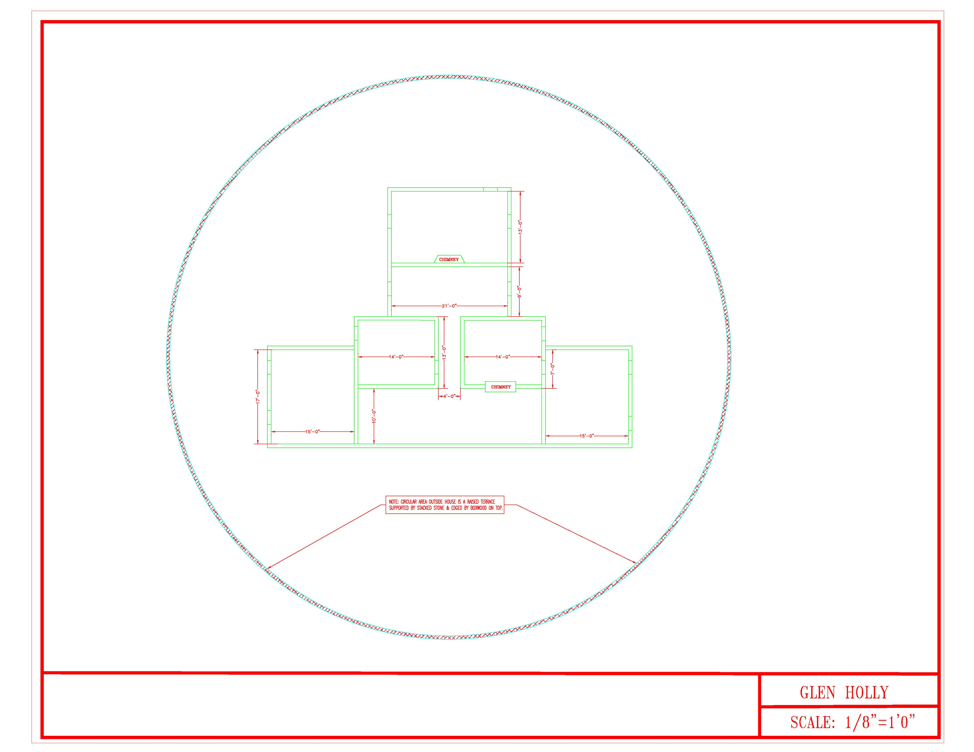
Since there are few pictures of Etowah, we rely on records of past residents. The town is described by J.W. Joseph as having a boardinghouse and twelve dwelling houses. There were two hundred acres of farmland and four acres of vineyards. There were private log homes.
The private residence for the owners, Stroup and Cooper, were located up the river at a distance from the mills, to get away from the noise of machinery.[1]
Cooper’s furnace worked forty-five weeks a year and produced up to thirty tons of pig iron each week. The price of iron at the time was brought up to twenty-five dollars per ton. In modern terms, Etowah Mining Company would have grossed about $21,000 per week. Once one of the busiest places in the entire South, Etowah grew into an industrial town with hundreds of workers and included slave labor.
Originally constructed in the late 1830s by Moses Stroup and his father, the iron furnaces were the early industrial parks of Bartow (then Cass) County. In1847 Georgia congressman Mark Anthony Cooper and a financial partner, Andrew M. Wiley, purchased the furnace and many related businesses from Moses and worked together to build Etowah.
The manufacturing town grew to two thousand people at its peak and contained a rolling mill, flour mill, carpenter shop, foundry, spike and nail mills, a hotel and workers’ homes. Etowah had a spur track connecting to Western Atlantic Railroad (W&A) that Cooper financed himself.[2]
The railroad had an engine called Yonah. It not only shipped freight to Etowah Crossing—Yonah played a role in the Great Locomotive Chase during the Civil War.
The products made and shipped from Etowah were pots or hollow ware, tools, cannons, spikes, nails, pig iron and other molded or rolled iron. The rails for Cooper’s beloved railroad were first manufactured in Etowah. Cooper was selling products world-wide. Georgia did not have a market for iron, but he diversified and sold other products.
Etowah always struggled financially. Cooper said the flour mill was profitable. The Cooper mills produced flour in a five story flouring mill. By 1849 was producing fine flour. Cooper’s flour was touted as the finest flour – “fit for a queen.” In fact, Major Cooper sent several barrels to Queen Victoria. Later, he received a letter from the Queen’s secretary saying, “The flour had arrived in good condition and Her Majesty had enjoyed the bread made of it and thanked Major Cooper for his kindness.”[3] The Old Major priced his flour for profit as he undercut local markets selling at cost.[4]
According to 1988 article in North Georgia Journal, Etowah had it all. David wrote, “The thriving little town had a combination school and church; a boarding house; a bordello; a bank; a post office; a brewery; a company store; and log houses for the workers and their families.” [5] In 1852, Etowah had a population of 1,832. This may not seem very large, but the county seat, Cassville, was the largest settlement, with a population in this same year of 1,794. Francis Adair was interviewed Mrs. Roe Knight in 1930 and left this picture of Etowah:
The land was then laid off into streets, lots, and localities. A few of the more important structures which immediately went up were: The Church, school house, President’s office, bank, boarding house, and several large stores. The chief boasts of the town, however, were the railroad turn table and the post office.
Mrs. Knight mentioned a barrel factory with a usual daily output of 250 to 300 barrels. She spoke of a brewery and mentioned an iron warehouse connected to the railroad line, constructed to store all the pig iron produced when it was not profitable to sell it.[6]
Taking Care of His Own
Cooper was a benevolent man; he cared for the workers and the families in Etowah. The lost town had log cabins for the workers, a company store, and a school/church. His iron did not sell well in Georgia, but he had a product that sold well in New York markets. He started making hollow ware for cooking and built a five story flour mill. He had to diversify to keep his workers paid. He was concerned for them, but not in a judgmental way. Proof remains that he tried to help them leave at least one vice behind.
The Coopers found an old wine label in the papers. In addition to iron, flour, cornmeal, and produce, the Old Major made wine. Mark Anthony Cooper imported German grapes and a German winemaker. Mark Cooper, remembers his grandfather’s wine press in a 1958 family document. He says the wine press stood across “a little hollow from the springhouse.” He details someone made the old wine press of wood and had two stories. Cooper remembers, “There was also an enormous screw, or helix, used in the press to squeeze the wine out of the grapes. As I recall it, this was made in the Works, and it was approximately four or five inches in diameter, and quite long. I don’t recall the length-some seven or eight feet, I would say”.[7] Mark A. Cooper explains:
The wine press was on the side of the side of the hill, the grapes were brought in on the uphill side into the second story, which was of wood, where the actual press was. Down below were barrels, enormous ones. My grandmother has said some of them were six feet across. I seem to remember seeing the hoops of some which would be a little smaller than, possible 4 or 5 feet, though that’s been a long time ago. [8]
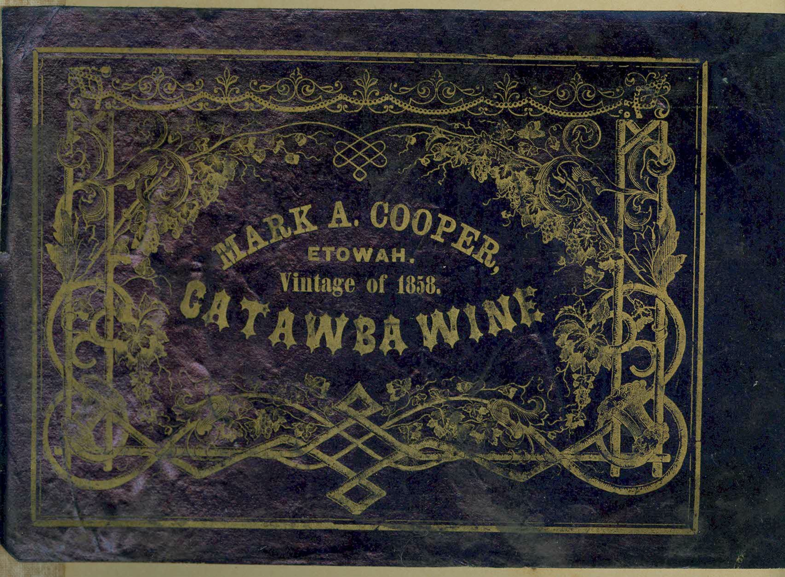
Cooper continues to describe the spring house that housed the wine press:
The spring house consisted of an open court, with a curing stone staircase going down into the spring, which was encased in as tone curb, or whatever you call it, and which flowed through a hole in that burb, across a channel cut in flagstones, into the spring house proper
In this, there were two long stone troughs with spring water in them, possibly eight inches deep. These troughs were probably two or three feet across, the sides being made of one piece of stone, and they were probably six or eight feet long. This took the place of a refrigerator.[9]
He wanted to keep his men away from using corn liquor or white lightning. Mark A. Cooper says, “This never was very successful.”[10] Catawba wine was just not the same as the hard core moonshine for the hard-working men of the Etowah Iron Works.
In some ways Cooper was a mystery, The New Georgia Encyclopedia tried to explain the man, “A believer in temperance, he opposed the prohibition laws that dominated political discussion in the last years of his life.” [11] Maybe he felt wine was better than white lightning. Perhaps Cooper was not a legalist and knew people were won by respect and love – not laws.
Mark Anthony Cooper had an unwavering faith. A faith he passed down to his children and grandchildren. He did not touch alcohol or tobacco and was faithfully married to his wife Sophronia for 56 years. So, when he built his company town (Etowah) why did he make wine and have a bordello in Etowah? His great grandson explained, Mark Anthony Cooper was about peace and letting others live their lives.[12]
He wanted to create community among his workers, so he was not judgmental. Cooper, however, provided opportunities for others to find faith. He built a church and introduced revivals and special meetings to his community. Mark Anthony Cooper was a leader in local Baptist associations and even help start the Southern Baptist Convention at the time of the War Between the States. Cooper’s deep faith caused him to love his family and his employees and not judge them.
Cooper fostered loyalty among his workers, but also among other business men. On the brink of bankruptcy in early 1850s, thirty-eight friends helped him and by the end of decade he had repaid his debt. In 1859-1860 he created a one of a kind memorial to those thirty-eight friends who helped him save the Cooper Iron Works. This Friendship Monument moved around, but is currently in downtown Cartersville next to the former depot.
Cooper was an industrial giant in North Georgia in the early 1800s bringing the railroad to the region and advocating industrial growth. Although he left “King Cotton” behind to mine the minerals in Bartow County, he was the founder and presiding officer of the organization that became the Georgia State Agricultural Society in 1846. Cooper invested heavily in Confederate bonds and did not want to appear to doubt the legitimacy of the Confederacy. That decision would cost him and leave him destitute when his iron works was destroyed as a byproduct of the Civil War. [13]
War
Civil War played an important role in the life of Etowah and Glen Holly. When war came to North Georgia, the Cooper family lost more than the manufacturing village of Etowah. They lost all their wealth and two sons; Frederick and Thomas died from wounds suffered in battle.
Cooper bet on the Confederates. He sold the Iron Works and then invested in the Cause. He took the proceeds of the sale and sunk it into Confederate bonds. At the end of the war, he was destitute.
Union soldiers did not invade Glen Holly or destroy the Cooper mansion. The family cemetery was preserved. His two Confederate officer sons were buried there under the huge magnolia trees. Mark Anthony and Sophronia continued to live in their home until Sophronia died from pneumonia in 1881. Uncle Eugene and Aunt Rosa remained unmarried and served as their parent’s caretakers.[14]
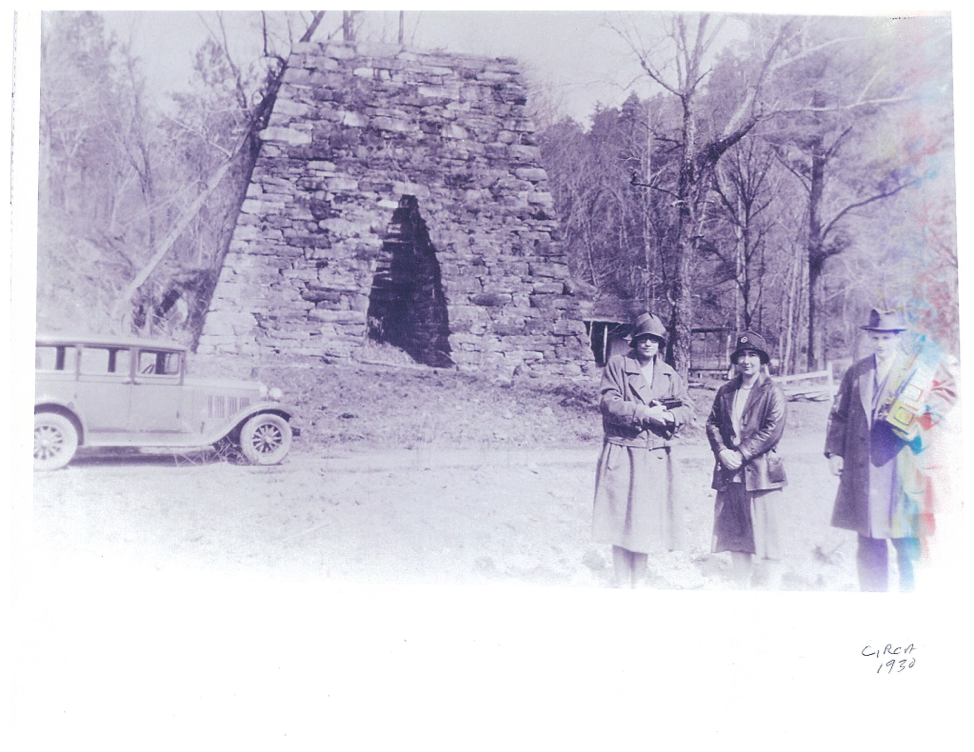
The Union soldiers could not find the Iron Works as it was not a usual location for a large manufacturing town, nestled in the hill. A local story (that cannot be verified) is that locals, who happened to be German, showed Sherman’s soldiers where Etowah was located. Years later, during World War I, those same residents of German descent were turned in to the authorities.
According to Cooper’s great-grandson, “Mark A. Cooper was crossing the river when the troops destroyed the rolling mill, the flour mills, and the other facilities and buildings.” The Federal Army not destroyed his Iron Foundry, but they flung the friendship monument into a well. Glen Holly, Cooper’s home on a little knoll near the Etowah River and away from the Works, remained unscathed.[15]
Fire
Glen Holly had a fire in the1850s, but the blaze that finally brought Glen Holly down was on July 4, 1884. A chimney fire devoured the Major’s “curious and valuable relics” from his vast life. His son, Eugene, had a flair for the dramatic as evidenced by the story he wrote for the Atlanta Journal. He wrote, “The fire caught from the burning soot in one of the chimneys, and made such rapid program before it was discovered that nothing of any value was saved.” He explains that Major Mark Anthony Cooper lost many books and important documents, but the fire erased even more. The article continues, “It has been for 30 years the home of the most generous hospitality, and there are thousands of Georgians who will remember pleasant hours spent there.”[16]
After the fire, without his wife, the widower was without a home. Cooper moved into a building on the property that belonged to one of his workers. Less than a year later, Mark Anthony Cooper died in Glen Holly in Hezekiah’s house with his unmarried children Eugene and Rosa (and other family members) at his side.[17]
Wild
After the fire and Mark Anthony’s death, Glen Holly was abandoned and feel into disrepair. John Paul Cooper wanted to preserve something of the past.
The Etowah Iron Works property left the Cooper’s hands during the Civil War, but they were still interested in preserving the old furnace stack. John Paul Cooper writes to a Mr. George H. Aubrey in 1916, “I have not given up the hope of buying the old furnace stack near my property on the Etowah River. ” Georgia Power, even at that early date, wanted to dam the Etowah River and flooding Etowah Village and Glen Holly.[18]
Aubrey, an attorney, responds to Cooper that he felt there was little chance that he could purchase the stake. He says, “The Munfords and some of their friends have created a little summer colony in the gap, close to the old furnace stack, building cottages, etc, and I doubt their willingness to part with anything at that point.”[19]
Cooper continues his correspondence with another letter stating: “I hope the Mumfords won’t be obdurate. I will accommodate my plans to those of the summer colony. I feel sure there would be no cottages built within the space I would wish to enclose.” He wanted to enclose the furnace for historical preservation and make improvements like growing grass. He offered the Mumford the use of his spring on his land and will clean it up for them to use.
The next letter from Aubrey conveys Mr. Mumford’s response to Cooper’s request to preserve or buy the old furnace. Mumford said, “No.” Aubrey let Cooper know that he was in bad health and things could change.[20]
Family correspondence shows a variety of care takers, log poachers, vandalism and the things they tried to do to protect their home place.
In a series of letters between Walter, Frederick, and Mark describe what was happening to the property. In August of 1929, Walter G. Cooper, an Atlanta historian writes to Frederic and asks, “Can you tell me whether the road to Glen Holly from the railroad bridge, or from Cartersville is passable? Is there a tenant on the place?”[21] Walter had not been to the property since his mother’s funeral in 1915. One month later Walter writes again, “I went to Glen Holly yesterday.” He continues, “We had not serious trouble until we got to the little spring where you turn off the main road about a quarter of a mile from Glen Holly. There it was so marshy that we had to park the car and walk the rest of the distance to the home place.”
Walter describes his run in with a poacher who had set up a portable saw mill on the property: “There was no one in sight when we passed but as we were eating our lunch at the home place a large man with a long beard, apparently 65 years old, rather rough looking, came by and went around the house. I asked him if he would have lunch with us, but he said no and went on.”[22]
The home place upset Walter as he told Frederick,
“I was made very sad and somewhat shocked to find the home place overgrown with young trees, 10 or 12 feet high and covered so densely that we could not even see the foundations of the old house until we had threaded out way through he trees from the front stone steps. The whole place was more or less covered with undergrowth so that even the road that approached the house was obscured.”[23]
Walter continues to describe the condition of the cemetery. He said it was difficult to get there, but once there the large magnolia had blocked the excessive growth of weeds. He goes on to pass along that bootleggers had been on the property, but he revenue agents had cleared them out. He thought this location would make a great resort once Georgia Power built the dam across Mount Moses and Mount Leroy.
Frederick finally responds to his Uncle in October. He was grateful for the tip about the saw mill and lawyer cousin Aubrey was on it. He explained that getting a caretaker at Glen Holly was difficult, “The is no attraction there for a responsible man, because the land in its present condition does not warrant farm; and it would be quite expensive to put responsible man there on full-time pay.”
Ten years later, Uncle Walter wrote to his nephew Frederick once again about the dam. Walter writes, “In the Engineers Report they suggested build a dam 80 feet high in the Etowah River between Mount Moses and Mount Leroy, about ¾ mile from Glen Holly. ” [24] He suggests a cement wall be built around the cemetery. Walter reminds Frederick that the condition of Glen Holly has deteriorated making entrance to the home and gravesites impossible. Frederick replies to his uncle, “We have intentionally let he road into the place become practically impassable because we were subject to a very undesirable sort of trespass there, as long as access was easy.”[25] One decade later, it would no longer be an issue.
Water
The next phase in Glen Holly’s life was the dam construction. The U.S. Army Corps of Engineers started work on the Allatoona Dam project in 1941, but World War II halted all work. Once the project resumed in 1946, a number of sites were identified to be at risk of being covered by the rising waters. The old village site of Etowah was ground zero for submersion. Glen Holly’s and the Village of Etowah were mostly located on the northeast side of Allatoona Dam and not entirely around the Cooper furnace which stands today. Several other sites also fell victim to rising waters. Among those were the Allatoona Pass rail community, Abernathyville or Old Macedonia, two iron furnace sites, mining sites, several cemeteries including the Cooper family cemetery and Glen Holly, home of Major Mark Cooper.
By 1949, the dam was complete, and the waters poured into Etowah. While pieces of the town survived the Civil War and fire did it’s work, water finished the job. Water covered the remnants, including Glen Holly and the family cemetery.
The Cooper family had to go to court and fight for proper re-internment of the graves. They required certain things be done including placing a copper plate at the new graves in Oak Hill Cemetery. The U.S. Corp moved Sophronia and Mark A Cooper along with family members. Three children who died young were encased in high quality iron caskets made in the Iron Works. These caskets were once attributed to the patriarch and matriarch, but the iron caskets belonged to three of their children who died young. The large iron casket may contain two children .
The government took its time to place the copper Cooper memorial at Oak Hill. In true government fashion, the delay was blamed on a “copper shortage.” Simple words on the memorial explain what happened at Glen Holly:
In Memoriam
This family cemetery containing eleven graves was removed from Glen Holly in 1949 to permit construction of Allatoona Dam and Reservoir. Erected by Corps of Engineers.
In true Cooper fashion, loyalty to friends was important. Jim Knight’s property was in the impoundment area. The Cooper tried to help Jim keep his property. They wrote several letters to government officials pleading Jim’s case. They made it clear that they were not concerned with Cooper property, but were concerned for Jim Knight . After a failed letter writing campaign, the Army Corps took Knight’s property for the reservoir.
Ghosts
These words appear on a board on a hiking trail at the Cooper’s Furnace Day Use Area:
“Since the ironworks at Etowah were too valuable to the Confederacy to be left intact. Federal troops set them ablaze along with much of the surrounding town. It was a fatal blow. Industrialist Mark Cooper lived on at his home ‘Glen Holly’ until 1885, but Etowah would soon be shrouded in the mists of time and forgotten by most.”
This plaque was near the old iron furnace stack John Paul Cooper wanted to buy and preserve for history. John Paul was not able to purchase the furnace, but in the end it was preserved.
In family lore, the Coopers passed down many stories about the eccentric Uncle Eugene. When Glen Holly was in ruins, and Eugene still lived in one of the buildings on the property, he would go out every evening and blow a long “spirit horn.” A spirit horn was an old Southern tradition that was supposed to chase away the ghosts. The Coopers may have felt haunted with all the lost surrounding Glen Holly.
While this fit Uncle Eugene’s personality, most believed it was fiction. In the 1970s in the barn attic of Woodhaven, John Paul Cooper’s home, a long spirit horn was found. Eugene followed in an ancient southern tradition of blowing the long trumpet to chase away the ghosts of Glen Holly.[26]
Ghosts of Glen Holly Present remain on the land as the water recedes once a year to reveal the old home place and its antebellum past. But it does not end there. While fires burned many family documents and valuable books, the past haunts and requires something more.
Ghosts of Glen Holly Past guide us how to live a life worthy to be remembered. The Coopers moved about North Georgia and left their legacy in education and industry. John Paul and Alice Allgood Cooper helped establish Darlington Schools. Shorter College was created and nurtured by Hattie Cooper. Many Shorter buildings are named for the Coopers. The Chamber of Commerce in Atlanta was started by a Cooper. Several industries were born and sustained by John Paul Cooper. The family is full of historians, both amateur and professional.
The story continues in all the lives touched by the educational and industrial contributions made by the Coopers. The story is not over. The next chapter has just opened, “The Ghosts of Glen Holly Future.
Bibliography
A Monument to His Friends Erected By Mark A. Cooper. Cooper Family Papers, n.d.
Bob, Andrew. “The Lost City of Etowah.” Backroads Georgia, Summer 2005, 29-32.
Cooper, Eugene. “The Cartersville American has this about the burning of Major Cooper’s residence.” The Atlanta Constitution (Atlanta), July 10, 1884, 528. http://www.newspapers.com/clip/369487/the_atlanta_constitution.
Cooper, Frederick S. “Letter to Walter G. Cooper.” Atlanta. Last modified May 2, 1938.
Cooper, Frederic S. “Letter to Walter G. Cooper.” Atlanta. Last modified October 8, 1929.
Cooper, John Paul. Letter to Mr. George H. Aubrey. Cartersville, GA: John Paul Cooper Family Papers, 1916.
Cooper, Mark A. “Letter to Walter G. Cooper.” John Paul Cooper Family Papers. Last modified September 17, 1929.
Cooper, Mark A. “Mark Anthony Cooper’s Remembrance of The Old Major.” John Paul Cooper Family Papers. Last modified 1958.
Cooper, Walter G. “The Old Etowah Iron Works.” Dixie (n.d.), 41-44.
Cooper, Walter G. Letter to F.S. Cooper on September 16. Rome: John Paul Cooper Family Papers, 1929.
Cooper, Walter G. “Letter to Frederick S. Cooper.” Rome: John Paul Cooper Family Papers, 1938. Last modified January 6, 1938.
Cooper, Walter G. “Letter to Frederick S. Cooper.” Rome. Last modified April 28, 1938.
Cooper, Walter G. “Letter to Mr. F.S. Cooper August 16, 1929.” John Paul Cooper Family Papers. Last modified August 16, 1929.
Davis, Jr., Robert S. “Trace Elements of A Vanished Empire: The Story of the Community of Etowah.” North Georgia Journal, Spring 1988, 31-34.
Parker, David B. “Mark Anthony Cooper (1800-1885).” New Georgia Encyclopedia. Last modified August 21, 2013. https://www.georgiaencyclopedia.org/articles/history-archaeology/mark-anthony-cooper-1800-1885.
Russell, Lisa M. Lost Towns of North Georgia. Charleston, SC: Arcadia Publishing, 2016.
Russell, Lisa M. Underwater Ghost Towns of North Georgia. Charleston, SC: Arcadia Publishing, 2018.
Wright, Barry. John Paul Cooper: Georgia Giant in the Revival of Cotton During the Early 1900’s. Washington: Gorham Printing of Centralia, 2017.
Wright, III, Barry. Email Interview. January 2019.
[1] Lisa M. Russell, Lost Towns of North Georgia (Charleston, SC: Arcadia Publishing, 2016)
[2] Russell, Lost Towns
[3] A Monument to His Friends Erected by Mark A. Cooper, (Cooper Family Papers, n.d).
[4] Robert S. Davis, Jr., “Trace Elements of A Vanished Empire: The Story of the Community of Etowah,” North Georgia Journal, Spring 1988, 33.
[5] Davis, Jr., “Trace Elements of a Vanished Empire,” 33
[6] Russell, Lost Towns, xx.
[7] Mark A. Cooper, “Mark Anthony Cooper’s Remembrance of The Old Major,” John Paul Cooper Family Papers, last modified 1958.
[8] Ibid.
[9] Ibid.
[10] Mark A. Cooper, “Mark Anthony Cooper’s Remembrance of The Old Major,” John Paul Cooper Family Papers, last modified 1958.
[11] David B. Parker, “Mark Anthony Cooper (1800-1885),” New Georgia Encyclopedia, last modified August 21, 2013, https://www.georgiaencyclopedia.org/articles/history-archaeology/mark-anthony-cooper-1800-1885.
[12] Barry Wright, III, Email Interview, January 2019.
[13] Parker, “Mark Anthony Cooper.”
[14] Barry Wright, III, Email Interview, January 2019.
[15] Russell, Lost Towns, 84.
[16] Eugene Cooper, “The Cartersville American has this about the burning of Major Cooper’s residence,” The Atlanta Constitution, July 10, 1884, http://www.newspapers.com/clip/369487/the_atlanta_constitution.
[17] Barry Wright, III, Email Interview, January 2019.
[18] John Paul Cooper, Letter to Mr. George H. Aubrey, (Cartersville, GA: John Paul Cooper Family Papers, 1916).
[19] Cooper,” Letter to Mr. George H. Aubrey.”
[20] Ibid.
[21] Walter G. Cooper, Letter to F.S. Cooper on September 16, (Rome: John Paul Cooper Family Papers, 1929).
[22] Ibid.
[23] Walter G. Cooper, Letter to F.S. Cooper on September 16, (Rome: John Paul Cooper Family Papers, 1929).
[24] Walter G. Cooper, “Letter to Frederick S. Cooper,” Rome: John Paul Cooper Family Papers, 1938, last modified January 6, 1938.
[25] Ibid.
[26] Barry Wright, John Paul Cooper: Georgia Giant in the Revival of Cotton During the Early 1900’s (Washington: Gorham Printing of Centralia, 2017).

